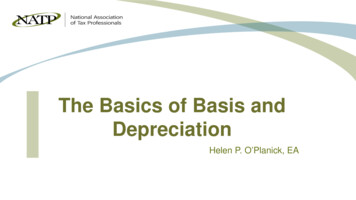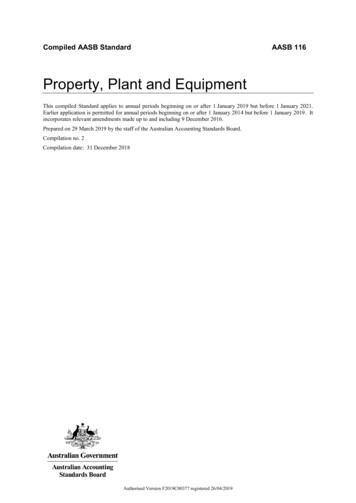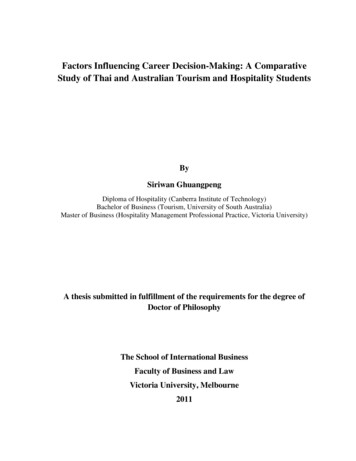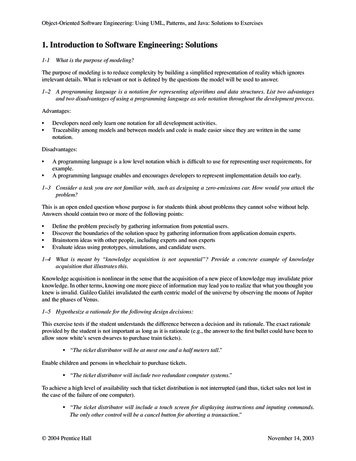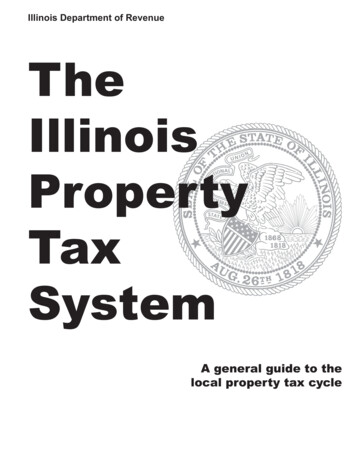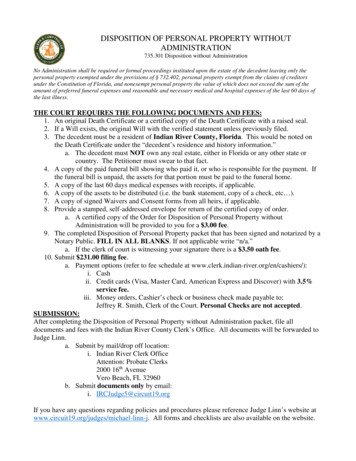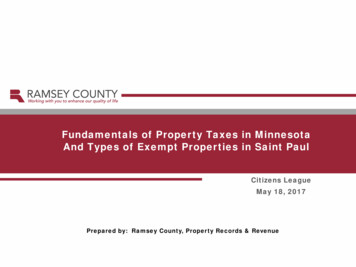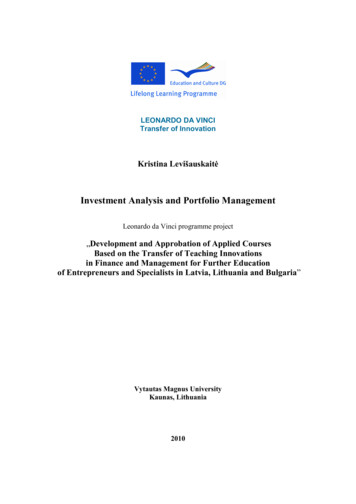
Transcription
International Journal of Accounting & Business ManagementVol. 7(No.2), Nov, 2019ISSN: 2289-4519DOI: 10. 24924/ijabm/2019.11/v7.iss2/94.113This work is licensed under aCreative Commons Attribution 4.0 International s/ijabmResearch PaperFACTORS AFFECTING PROPERTY INVESTMENT DECISION MEDIATEDBY BRAND IMAGELiong Ooi Weiweiliong 1999@yahoo.comLord Ashcroft International Business School,Anglia Ruskin University, UK (FTMS MalaysiaCentre)Arwa EissaSchool of Accounting and BusinessManagement, FTMS College, Selangor,MalaysiaAbstractThe real estate sector in Malaysia is one of the key contributors for National GDP and the maindrivers of Malaysian economic growth. Despite the property market remains sluggish in the recentyears, property investment still continues to be an attractive investment option. This study aims togain information and insights into the factors that affect the property investment decision thatinfluence investment planners, policy makers, property developers, marketers, real estate agentsand financial institutions to improve their property investment decision and its performance. Thisis essential as every individual is different from others due to different financial capability, risktolerance and demographic criteria such as age, gender, social and economic background andeducational level. Keeping this in view, a study model has been developed to explore the financialfactors, psychological factors and demographic factors that impact investment decision and toexamine the weight of role of brand image that attached to each independent variable whenmaking investment decisions. The findings and discussion are based on a total of 303 responsesusing convenience sampling through self-administered questionnaire. Data collected wereanalysed with SPSS 22 and SPSS PROCESS Macro. Overall findings concluded the financial factors,psychological factors and demographic factors are validated with direct positive impact toproperty investment decision. Brand image on the hand, plays a significant role in each factorwhen making investment decision.Key words: Financial factors, Psychological factors, Demographic factors, Brand image, Propertyinvestment decision1.IntroductionProperty industry is one of the key contributor for Malaysia’s National GDP, comprises 5.1% ofall other significant sectors (DOSM, 2018). It is thereby essential to consider the growth of realestate sub-sector to attain the sustainability of National GDP. However, Malaysia propertymarket has sharply slowing down since 2017 due to slower economic growth with moreuncertainties expected (Ganeshwaran, 2018). Malaysian house prices is average 5 times theannual median household income as compared to 3 times the international affordabilitystandard, resulted houses in Malaysia seriously unaffordable even though Malaysia’s propertyprices is increased slower than other countries (Bank Negara Malaysia, 2017). Houses areunaffordable with 67% of Malaysians age below 35 are still looking for properties (TheEdgeProp, 2018). This has consequently led to the issue of oversupply of unaffordableISSN: 2289-4519Page 94
residential properties. 130,690 units of unsold residential property are reported in 2017, beingthe highest in the decade. (Eugene, 2017).To overcome the oversupply issue, Malaysian Government has freeze some of the luxuryprojects (George, 2018) and has also undertaken some anti-speculation measures such asstricter bank lending guidelines and increment of Real Property Gain Tax (RPGT) to overcomethe speculation in the market (Andy, 2019).Brand image has increasingly important and cannotbe undermined as it is increasingly synonymous with our everyday lives. Strong brand imagehelps people to attain sense of belonging (Roll, 2006). Thus, branding should be given a highdegree of importance and this study will contributes to the knowledge in the context ofproperty industry as this is among the first to study the mediating role of brand image inaffecting property investment decision.This study allows the researcher to determine the factors and the mediating role of brand imagein making property investment decision. It contributes new insights to the exiting literature byfilling the knowledge gap that is not being address in the past which is the mediating role ofbrand image in property investment decision. Investors should possess extensive knowledge inrelated to significant factors and the mediating role played by brand image in makinginvestment decision. Better understanding and prediction of real-estate market can be achievedif there is better understanding of the factors that influencing property buying behavior (Chongand Dastane, 2017; Daly et al., 2003). Thus, it is significant to conduct a study target to thedevelopers, bankers and property agents and policymakers to provide in-depth understandingof the factors affecting investors ‘decision which eventually can improve customers satisfaction,boost up property sales and consequently overcome the overhang properties issue in Malaysia(Hoe, Dastane, and Selvaraj, 2018). It can serve as knowledge for the researchers and to supportany future research in related to property investment decision.Research objectives include: To analyze the relationship of psychological factors and propertyinvestment decision, To analyze the relationship of financial factors and property investmentdecision, To analyze the relationship of demographical factors and property investmentdecision, To analyze the mediating role of brand image that related to the consideration of keyfactors in property investment decision.2.Literature ReviewInvestment decision involves rational analysis, evaluation and choice selection (Miles et al.,1989). Property investment decision further defined as an estimated financing decision toevaluate the wealth includes any acquisition or disposal of real estate assets (Hargitay & Yu,1993). The investment process always influenced by the objectives of investors includesforecast, outlook, funds availability, investor’s objectives, historic performance, risk and returnpreferences and market considerations (Ginevicius and Zubrecovas, 2009). Investment decisioncan be a structured as rational process and judgement can be made using factual data andleading to optimal decision-making (Gallimore, et al., 2002). Expected Utility Theory (EUT) byDaniel Bernoulli (1954) has been generally applied and dominated the analysis of decisionmaking under risk. EUT assume investors are rational and risk aversion when exposed touncertainty where mathematical facts on probabilities are applied to calculate risk andinvestors tend to be risk averse by choosing the least risky prospect in any given situation.However, investors are sometimes behave irrational. Prospect theory (PT) was put forward byKahneman and Tversky (1979) to disagree the assumption of EUT. It believes investors areirrational but have sense to lose and exhibit risk aversion when making investment decisions.PT assumes investment decisions is influenced by irrational behavior under uncertainty byweighting more on perceived gains rather than perceived losses. Many studies show that PT isin relation with investor behavior when making investment decisions. (Bernard and Thomas,1989; Das and Lev, 1994; Sankaraguruswamy, 1996). Different people with differentbackground and therefore hold different views, beliefs, attitudes and perceptions when makingchoices in property investment. Brand Asset Valuator Model (BAV) by Young & Rubicam (1990)ISSN: 2289-4519Page 95
is a model using metric to evaluate brand equity. BAV based on the perception of customerswith respect to universal brand characteristic used to determine brand value. It relates brandvalue for the role of differentiation, reference, esteem, knowledge to brand vitality and brandstature.From the review of the previous published research (Table 1), many studies focused on theimplication of financial factors on property investment decision Various financial factors havebeen explored by researchers to determine its impact on investment decision which includewealth accumulation and capital gain (Susan and De Bruin, 2000), financial, ability of financing(Chia et al., 2016), property price (Rath, Mahapatra and De, 2014; Nelson et al., 2014) andincome of investors (Sridevi and Saranya. 2018; Chong and Dastane, 2017). Financial factors hasalso found to influence only to first time house buyers (Anastasia and Suwitro, 2015) andfinancial strong buyers have different property choices than financial weak buyers (Dikshitaand Mohammedshakil, 2018). Studies from Riaz,, Hunjra and Azam (2012) ; Seetharaman et al.(2017) were mainly focused on the impact of risk attitude of investors in making propertyinvestment decision while the relationship of psychological aspect of overconfidence onproperty investment decision was studied by (Bakar and Yi, 2016; Dittrich and Maciejovsky,2005). The relationship of herding bias and investment decision was conducted by (Grover,2015; Simeon, Wallace and Mogwambo , 2016).The relationship of demography and property investment are found from studies conducted bySeelig et al. (2009); Bujang et al. (2010); Majid, Said and Daud (2017). Variables recognized inprevious studies are very similar to this study. However, mediating effect of brand image is stilluntouched in particularly studies in Malaysia. Thus, it is essential to address the uncoveredissues in this study. Therefore, expanding brand image in this paper is necessary to enhancetheoretical framework for a good understanding of the determinants of brand image in makingproperty investment decision.2.1 Conceptual FrameworkISSN: 2289-4519Page 96
Financial Factors: Financial attributes in property investment decision include mortgageinterest rates, housing price, financial return and ability of financing where it would impactnearly 30% of investors’ decision when buying a property (Reed and Mills, 2006). Wealthaccumulation and long- term capital gain greatly impact the property buying decision ( Susanand De Bruin , 2000) where financial knowledge has contributed 30% on the propertyinvestors’ decision (Reed and Mills , 2006). Financial factor would cost investor dearly if it is notconsidered when buying a property (Sean and Hong, 2014). Mortgage rates, household income,house price and financing are the factors considered by property investors. The expectation ofreturn and capital growth are greatly affecting the investment decision (Tan et al., 2015). Inreal- estate, financing is a common mean when buying property, the ability of financing from thefinancial institutions is greatly influenced the property investment decision (Chia et al, 2016).Psychological Factors: Psychological have an impact on investors ' decision-making in related tothe markets (Kahneman and Riepe, 1998). According to Abul (2019), psychological factors oninvestor behavior includes overconfidence, herding behavior and risk tolerance. Overconfidentinvestors believe they are smarter than others to invest at the best time, best cost and at thebest price and will over-estimates precision of personal knowledge (Odean, 1998).Overconfident investors always use their emotions to manage their investment portfolio (Tonand Dao, 2014) and this behavior will impact investors’ decision when buying property as theybelieve can control the market (Rath, Mahapatra and De, 2014; Grover, 2015). Overconfidence isconcluded to have direct effect on investors’ behavior when making their decision (Bakar andYi, 2016). Herding behavior refers to “follow the leader” where individual has tendency tofollow the crowd, assuming the decision made by majority are always correct (Scharfstein andStein, 1990). Herding is common when investors have high expectation on return (Grover,2015). Findings shown herding has positive significant impact on real-estate’s growth andperformance.Risk was proposed by The Committee on Insurance Terminology as “Uncertainty as to theoutcome of an event where two or more possibilities exist” (American Risk and InsuranceAssociation, 1966). In an emerging markets, investors may reflect risk-loving behavior(Antoniou et al., 1997) which commonly found in overconfident investors (Dittrich andMaciejovsky, 2005). Risk tolerance will determine the investment style of an investors (Riaz,Hunjra and Azam, 2012; Seetharaman et al., 2017).Demographic Factors: Demography is defined as density, population growth, population sizeand, marital status (Plane, 1993) which can be a measurement for housing demand (Swan,1995). Age greatly impact property investors when buying houses (Swan, 1995; Evan, 2004;Krainer, 2005; Lutfi, 2010). Different marital status resulting different property preferences(Lutfi, 2010; Suaid, 2012). Married people prefer to invest properties as compared with youngmarried couples whereas old married couple do not have intention to invest in property.ISSN: 2289-4519Page 97
(Bourassa, 1994; Morrel, 2001; Leppel, 2007; Fontenla & Gonzalez, 2009). Investors withdifferent education level have different demand on property types ( Hurtubia et al., 2010) anddifferent gender have different investment decision (Livette, 2007)Brand Image: From 1950 through the 1970s, brand image was described as the sum of thecognitive and affective expectations of the customer together with the physical characteristics ofthe product. (Newman, 1957; Herzog, 1963). When relate brand image to consumer behavior, itbelieves can reflect morals and self-imagery of customers (Hendon & Williams, 1985; Sirgy,1985). Brand image is a set of brand beliefs (Kotler, 1988) and is related to customers’memories (Keller, 1993) while Kapferer (1994) defined brand image as consumers’ generalperception about the brand feature. The positive impact of brand image on propertyinvestment decision are testified by Chia et al.(2016); Cheng and Cheok (2008) where propertyinvestors are brand conscious to the trend and professionalism of the property developers. Therelationship of brand image and property investment decision is consistent with the researchexpectation even though not many empirical studies in relation to this hypothesis.Based on the previous discussion, several hypotheses were formulated as follows:H1: Financial Factors have significant positive impact on property investment decision.H2: Psychological factors of overconfidence, herding bias and risk tolerance have significantpositive impact on property investment decision.H3: Demographic factors have significant positive impact on property investment decision.H4: Brand Image has a significant positive impact on property investment decision.3.Research Design and MethodologyIn this study, explanatory design was used in considering its flexibility and allows researchers tochange direction due to the new insight of the research (Saunders et al., 2009). This designemphasizes more on the relationship between cause and effect (Malhotra, 1999) thereby able toprove the proposed hypotheses to investigate and support the relationship how different thevariables can contribute to property investment decision. (Saunders et al., 2009). Quantitativemethod was used to collect data as it can generalize quantifiable results needed in this study.Quantitative method also provides clear documentation where future researcher can use as ameans for validity of findings (Saunders et al., 2009). This has been successfully demonstratedby researchers earlier (e.g. Jallow and Dastane, 2016; Oluwafemi and Dastane, 2016).Sampling: Self-administered questionnaires with Likert 7-point rating scale was used to collectdata. The final sample size for this study is 303. It is justifiable and fit to be used as there is notmuch deviation from the sample size in the previous study conducted by Sean and Hong (2014);Khim (2008); Tan et al. (2015); Seetharaman et al. (2017) where their sample size werebetween 150 and 500. Primary data were collected through convenience sampling method, anon-probability sampling technique which allows easy accessibility and geographical proximity(Dornyei, 2007). Web questionnaire were emailed and distributed through some of the socialmedia platforms such as Facebook, Twitter and WhatsApp’s groups with ethical approval fromspecific group administrator. This research is complied with Personal Data Protection Act 2010(PDPA) of Malaysia.Data Analysis Method: A descriptive analysis was conducted to analyze data related todemographic characteristic of investors. Tabulated statistical analysis and diagrams were usedto interpret investors' demographic profiles. The required analysis, normality, reliability andregression analysis were performed with the aid of SPSS 22 program while Model Fitness andModel of Significance were developed through SPSS Process Macro to determine the overallsignificance, fitness and the level of confidence of the model. Regression analysis was used todetermine relationship of these variables where:FF Financial FactorsISSN: 2289-4519Page 98
PF Psychological FactorsDF Demographic FactorsBI Brand Image4.Results and Discussion4.1 Descriptive Analysis:Out of 303 respondents, female are (52.8%) and male are (47.2 %). The gender proportion wasconsidered balance to provide different view from different gender groups in relation to riskexposure when making investment decision. Majority respondents were above age range of 4150 (88.2%) while age below 30 served the least respondents (11.8%). The collected datasupports the fact proposed by Ramanathan and Sundaram (2015) that investors whose agebetween 41-50-year preferred investment in real estate. Respondents for this study mainlyfrom income group more than RM 4,000 (85.2%) and only 5% who earned below RM 2,000. Themarried couples contributed 77.7% of the overall survey. 81.19% of respondents possesscertificate or higher educational while 18.8% were from high school level and others. Thus, therespondents in this study were in the best position to answer the survey as education associateswith level of understanding and financial literacy. The largest ethnicity group in this survey isChinese (61.3%), Indian (18%) and Malay (14.8%). Majority respondents are employed(48.9%) followed by self-employed (31.1%) and freelancer (8.8%) and military, homemaker,student, retiree and others (11%) (Table 2).ISSN: 2289-4519Page 99
ISSN: 2289-4519Page 100
4.2 Normality TestThe mean statistic was within 4.0- 5.0 and standard deviation was ranged 0.901 - 1.651 (Table3). The mean statistic is acceptable as it is within Likert 7-point scale that used to rate in thissurvey. Standard deviation has exceeded the acceptable range -1 1 as proposed by Hair, et al.,(2006), however, George & Mallery (2010) argued that distribution is still deemed normalunivariate distribution and acceptable for normal distribution even though both values areranged -2 to 2. The same has been recommended by several researchers (Animashaun,Tunkarimu and Dastane, 2016). Therefore, this study is deemed to be normal central tendencyof data distribution within the acceptable range of standard deviation.ISSN: 2289-4519Page 101
As shown in Table 4, both kurtosis and skewness ranged between-1.301 and 1.848. It hasexceeded the value as suggested by Hai et al. (2006). However, values for kurtosis and skewnessbetween -2 to 2 are acceptable and considered normal by George & Mallery (2010). Therefore,the skewness and kurtosis for this study are acceptable to indicate its .540.140.140.140.140.140.140.140.140ISSN: 2289-4519Page 79.279.279.279.279.279
8191.130.560.279.279.279.279.279.279.279.279Table 4: Skewness & Kurtosis4.3 Reliability TestThe overall Cronbach’s alpha score was 0.91, fall into the excellent internal consistency (Hair etal., 2010). The highest variable for Cronbach’s alpha is brand image (0.812) followed byinvestment decision (0.762) and psychological factors (0.708). The Cronbach’s alpha score forfinancial factors (0.595) and demographic factors (0.693) were not adhered to the rules assuggested by Hair et al. (2010) that the acceptable coefficient of reliability has to be greater than0.7. However, Nunnaly (1978) argued Cronbach’s alpha lower than 0.7 are acceptable assatisfactory indicator. Therefore, the data set used in this study is concluded reliable andsuitable.4.4 Analysis of Normality of the Dependent Variable:The histogram shown in Figure 2 is approximately bell-shaped and symmetric. It supports theexpected shape of normal distribution of data. Thus, the assumption of normality for this studyis acceptable and satisfactory.ISSN: 2289-4519Page 103
Figure 1: Histogram4.5 Non-Existence of Auto-correlationIn this study, Durbin Watson Test Statistic by Durbin and Watson (1950) was used to test autocorrelation of the sample data. It yield value of 1.661 which fall between 1.5 and 2.5, indicatingno violation of assumptions on the statistic (Hair et al., 2010). Thus, no auto-correlation amongthe variables and the independence of error is not a severe issue in this study. (Table 6)4.6 Multi-collinearityTolerance coefficients for financial, psychological, demographic factor and brand image was0.618, 0.495, 0.511 and 0.492. while VIF was 1.618, 2.019, 1.957 and 2.032 respectively (Table7). Both Tolerance and VIF value for this study were less than the threshold of 0.9 and 5suggested by Hair et al., (2010). Therefore, there is no critical levels of collinearity and noviolation of assumptions for all the independent variables in this study.4.7 Non-Existence of HomoscedasticityISSN: 2289-4519Page 104
Scatterplots for this model (Figure 3) shown a standardized and even distribution points withno specific pattern of data point and were not concentrated around a line. Thus, the model isvalid and the assumption of homoscedasticity is established as suggested by Hair et al. (2010).4.8 Normality of residuals of dependent variablesP-Plot for this study (Figure 4) shows a normal probability plot which cut across the regressionline closely, denoting strong correlation for predicted and observed values, without violatingthe assumption of residual’s randomness. Thus, the assumption of normality of the residuals forthis study is fulfilled and satisfactory as the plot of the predicted values of the dependentvariable versus the observed values are approximately linear (Hair et al., 2010).4.9 Regression AnalysisModel Fitness: R- square of the regression model is 0.525, indicating 52.5% of the propertyinvestment decision (dependent) are resulted from the effect of the factor of financial,psychological, demography and brand image while R was 0.805 which was more than 0.75,adhering to the rules (Hair et al. ,2013). Thus, it indicates a moderate fitness of the model.ISSN: 2289-4519Page 105
Model of Significance: P-value (Sig.) of .000 is aligned with the significance level of alpha value(Sig.) 0.05 or lower as suggested by Saunders et al. (2007) while F-statistic was 92.111.Therefore, the hypothesis test for this study is statistically significant and the high F statistic92.111 value proves high confidence and probability of getting the similar result if the samemodel was used for a different population.4. 10 Hypothesis Testing ResultsThe hypothesized relationship in this study is statistically significant as Sig. (p) value for all theproposed hypotheses were lower than value 0.05 (Hair et al., 2010) while the Beta coefficientwas H1 (0.376), H2 (0.301), H3 (0.126), H4 (0.399), H4a (0.217), H4b (0.255), H4c (0.303). In thisstudy, the indirect effect of brand image on each variable is determined by BootLLCI andBootULCI which tested through SPSS Process macro. The BootLLCI and BootULCI of brandimage on H4a (0.1486, 0.2958), H4b (0.1798, 0.3304) and H4c (0.2233, 0.3862) were rangedbetween 0-2 which are considered acceptable hypotheses (Fritz, Taylor & MacKinnon, 2012;Hayes & Scharkow, 2013). Therefore the mediating effect of brand image in affecting financialfactors, psychological factors and demographic factors in property investment decision areacceptable.ISSN: 2289-4519Page 106
5.Conclusion and RecommendationAccording to this survey, the factor of financial, psychological, demography and the mediatingrole of brand image on the respective factors in making investment decision are proved to besignificant and accepted. Property investment is a great way to gain financial return in eithershort-term or long-term run. Conversely, lacking of knowledge in the field would impact hugefinancial losses. Thus, extensive knowledge is essential by taking into consideration of thesignificant factors and the mediating role played by brand image when making investmentdecision. Findings from this study are crucial to provide guidance to investors, marketers, realestate developers, policymakers, real- estate agents and financial institutions involving in theproperty development process.Investors should gauge the factors that matter most before investing in property. The degree ofirrationality that exhibit through psychological biases; overconfidence and herding behaviorshould be avoidable to the extent that will not put investors into over gearing in borrowing.Instead, investors should gather in-depth property market information and to conduct riskassessment when making their choice of investment. Real-estate developers, agents, marketersand financial institutions are required to define the potential buyers’ profile to satisfiy theirpreferences by considering the aspect of financial, psychological and demographic to overcomethe current oversupply issue. This could help in building a successful marketing strategies andachieving a sustainable development in the sector.Branding, the main focus in many industries, has now spreading to the property industry. Brandimage, an evidence of value enhancer in the property market has to be seriously taking intoaccount by investors. Contrary, the brand equity should not be used as marketing gimmicks buthas to serve as a direction in any of the company’s strategic planning to establish strategies orinitiatives to improve and sustain a competitive position and business performance. Withgovernment‘s various cooling measures to curb speculation, it could develop a healthierenvironment, promote a stable and sustainable property market in the industry andcontinuously serves as a significant contributor to the country’s GDP.ISSN: 2289-4519Page 107
Despite the research has been conducted in an appropriate and precise manner, this papercontains several limitations that may hinder the contribution. Firstly, the sample of the researchis relatively small to represent the entire 32.02 million population in Malaysia as the analysiswas only based on 303 participants which may not adequate to cover all property investors.Time constraint is another key challenge where research was conducted within a short periodof time especially researcher had employed convenience sampling which highly relied on theavailability of the participants for the completion of questionnaires. Finally, resources forallocating participants who have real experience in property investment is limited.ReferencesAbul, S. J. (2019). The dynamic relationship between stock and real estate prices in Kuwait.International Journal of Economics and Finance, 11(5), 30-42.Animashaun, A., Tunkarimu, T. I. & Dastane, O. 2016. Customer Perceived Value towardsConvenience Stores in Malaysia: The Influence on Customer Satisfaction, Loyalty andRetention, Journal of Marketing and Consumer Behaviour in Emerging Markets, Vol. 2,Issue 4, pp. 4-27.American Risk and Insurance Association. (1966). Bulletin of the Commission of InsuranceTerminology of the American Risk and Insurance Association, 2(1), 33-42Anastasia, N. and Suwitro, A.L. (2015) the rational and irrational factors underlying propertybuying behavior. Journal of Economics and Behavioral Studies, 7(2), 183-191Andy, (2019) “All you need to know about Real Property Gain Tax (RPGT)” Available operty-news/real-propertygains-tax-rpgt/ Accessed on 12/09/2019 Antoniou, G. (1997). Nonmonotonicreasoning with incomplete and changing information.Bakar, S., & Yi, A. N. C. (2016). The impact of psychological factors on investors’ decisionmaking in Malaysian stock market: a case of Klang Valley and Pahang. ProcediaEconomics and Finance, 35, 319-328.Bank Negara Malaysia (2017) “Imbalances in the property market” Available athttp://www.bnm.gov.my/index.php?ch en publication&pg en staffinsight&ac 50&bb file Accessed on 07/08/2019Bernard, V. L., & Thomas, J. K. (1989). Post-earnings-announcement drift: delayed priceresponse or risk premium? Journal of AccountingRresearch, 27, 1-36.Bernoulli, D. (1954). Commentarii acad. Econometrica, 22, 23-36.Bourassa S. C. (1994). Gender, Marital Status and Home Ownership in Australia. Journal ofHousing Economics. 3(3), 220-239.Bujang, A.A., Zarin, H.A. and Jumadi, N. (2010). The relationship between demographicfactors and housing affordability. Malaysian Journal of Real Estate, 5(1), pp.49-58.Cheng, F. F., & Cheok, J. (2008). Importance of branding property developers in Malaysia.Sunway Academic Journal, 5, 65-81.Chia, J., Harun, A., Kassim, A.W.M., Martin, D. and Kepal, N. (2016). Understanding factors thatinfluence house purchase intention among consumers in Kota Kinabalu: anISSN: 2289-4519Page 108
application of buyer behavior model theory. Journal of Technology Management andBusiness, 3(2.Daly, J., Gronow, S., Jenkins, D., & Plimmer, F. (2003). Consumer behaviour in the valuation ofresidential property: A comparative study in the UK, Ireland and Australia. PropertyManagement, 21(5), 295-314.Chong P., H. & Dastane
Brand Asset Valuator Model (BAV) by Young & Rubicam (1990) ISSN: 2289-4519 Page 96 is a model using metric to evaluate brand equity. BAV based on the perception of customers with respect to universal brand characteristic used to determine brand value. It relates brand


